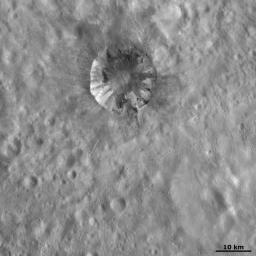This Dawn FC (framing camera) image shows Cornelia crater, a roughly 15-kilometer-diameter (9-mile-diameter) crater with a sharp, fresh rim. Cornelia crater has a spectacular internal structure, which consists of bright and dark material. This bright and dark material slumps from the rim and the sides of the crater towards the center of the crater. The top rim of Cornelia crater has partly collapsed and is also slumping towards the center of the crater. This crater has some dark rays, emanating from its rim, which extend for up to 10 kilometers (6 miles). The area immediately surrounding Cornelia crater is relatively smoother than the adjacent terrain. This indicates that there is a layer of fine-grained ejecta, which was ejected from the crater during its formation, surrounding it.
This image is located in Vesta's Numisia quadrangle and the center of the image is 11.5 degrees south latitude, 224.6 degrees east longitude. NASA's Dawn spacecraft obtained this image with its framing camera on Oct. 21, 2011. This image was taken through the camera's clear filter. The distance to the surface of Vesta is 700 kilometers (435 miles) and the image has a resolution of about 70 meters (230 feet) per pixel. This image was acquired during the HAMO (high-altitude mapping orbit) phase of the mission.
The Dawn mission to Vesta and Ceres is managed by NASA's Jet Propulsion Laboratory, a division of the California Institute of Technology in Pasadena, for NASA's Science Mission Directorate, Washington D.C. UCLA is responsible for overall Dawn mission science. The Dawn framing cameras have been developed and built under the leadership of the Max Planck Institute for Solar System Research, Katlenburg-Lindau, Germany, with significant contributions by DLR German Aerospace Center, Institute of Planetary Research, Berlin, and in coordination with the Institute of Computer and Communication Network Engineering, Braunschweig. The Framing Camera project is funded by the Max Planck Society, DLR, and NASA/JPL.
More information about the Dawn mission is online at http://www.nasa.gov/dawn and http://dawn.jpl.nasa.gov.

 Planetary Data System
Planetary Data System












